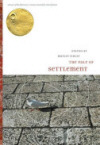The Pale of Settlement
The nine linked stories in this collection follow Susan Stern, a New York City photo journalist who often finds herself operating between two lives. The life she leads in the U.S. has its problems, relationships mostly, but she does all right. Her personal and familial ties to Israel and the Middle East, however, provide a much richer source for conflict. Bombs in Haifa, buzzing helicopters, border patrol violence, a massacre in Palestine–these events are merely background noise compared to the nuanced consideration of the personal lives and family history deeply imbedded within this chaos.
The nine linked stories in this collection follow Susan Stern, a New York City photo journalist who often finds herself operating between two lives. The life she leads in the U.S. has its problems, relationships mostly, but she does all right. Her personal and familial ties to Israel and the Middle East, however, provide a much richer source for conflict. Bombs in Haifa, buzzing helicopters, border patrol violence, a massacre in Palestine–these events are merely background noise compared to the nuanced consideration of the personal lives and family history deeply imbedded within this chaos.
Susan’s attempt to reconcile her place among members of her extended family, many of whom, unlike her parents, still live in Israel, makes up the backbone of this collection. In the story “Helicopter Days,” we see her develop a strange attraction to her cousin, Gavi, that is as much tied to her memories of her first summer on her own in Israel as it is to genuine intrigue and affection. Susan delivers the ashes of a dead relative to her uncle Avraham in “Deir Yassin,” a story that plays with form in a way that weaves past with current action, alternating between three points of view. These stories and others like them place Susan in the present, forcing her to interact with people and places that aren’t always familiar to her, but that are significant, nonetheless.
Coming to an understanding of her past has its own place in this book and, arguably, a more interesting one. Many of the stories are steeped in memory, both Susan’s and those of other characters. “Lila’s Story” combines Susan’s efforts to retrace her grandmother’s steps with her attempts to fictionalize the life of a woman she discovers she only partially knew. Memory itself becomes a source of conflict in its inconsistency, its inability, often, to separate stories from experience, the actual from the imagined, as Susan muses in “Lila’s Story”:
Back in Haifa…I retrace my grandmother’s steps…Here at the corner there used to be a handbag shop, dim and pungent…and here’s the newsstand where my grandmother bought me treats…There, I sat on a bench in the late afternoon while my grandmother told me stories…So are these my grandmother’s footsteps or my own?
Margot Singer’s investigation of what it is to remember and what it means to understand one’s past, while perhaps forcing certain connections and “chance” meetings, and relying on the description of photographs to give a sense of what was (a crutch the collection often returns to, yet, somehow, necessarily so.), rounds out an impressive first collection. Singer’s authorial hand is patient yet playful and confident when delving into the most personal of mistakes and shortcomings. The Pale of Settlement impressively divides and intertwines one family’s history with an ever-changing, uncertain present.





